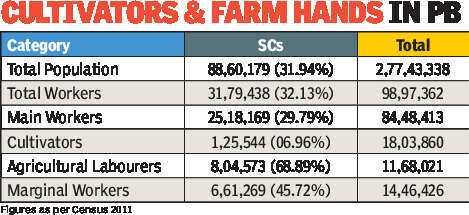Punjab: Dalit rural workers continue to be hit post-lockdown, finds study

CHANDIGARH: The post-Covid-19 situation in Punjab will remain precarious for scheduled caste (SC) rural workers, mainly due to unequal access to agricultural resources.
This has been brought out by a study undertaken by associate professor Deepak Kumar as part of the policy series by Punjabi University’s Centre for Development Economics and Innovation Studies.
This has been brought out by a study undertaken by associate professor Deepak Kumar as part of the policy series by Punjabi University’s Centre for Development Economics and Innovation Studies.
Development Economics and Innovation Studies.
It emphasises that as long as the issue of land ownership is not addressed, all subsequent development will invariably add to the existing structural inequality, mainly between Jat Sikh landlords and landless Dalit agricultural labourers.
The study recommends that besides creating more equitable access to land in rural Punjab through cooperative farming and other means, the state should ensure crop diversification and pay special attention to the agro-industry to absorb the teeming workers.

More than 85% of the SCs in Punjab do not own agricultural land and most of the working rural population is employed as landless agricultural labour. The study mentions that with larger population of workforce returning to their villages in Punjab during the Covid-19 pandemic, the SC workers have been exposed to greater risk than usual.
Focusing on various challenges posed to the most marginalised segment of workers, the study highlights that with the diminishing returns, agriculture remains insufficient to absorb the surge in available labour.
Pandemic
If earlier migrant SC workers employed in urban centres used to add to the family income back home through remittances, the Covid-induced lockdown and resultant loss of employment in cities has led to many of them becoming a drain on the family resources.
The recent economic crisis has pushed these SC workers back into the ambit of village politics where the lines of economic engagement are often determined by traditional caste hierarchy, underlines the study. The last few years have also witnessed rising demand among SCs for their share in village common land for their subsistence, which the Jat Sikhs have been resisting.
The marginalisation of Dalits becomes more obvious when one finds convenient acceptance of separate gurdwaras and cremation grounds for Dalits in almost all villages, the study says. To make matters worse, the big farmers prefer to hire cheaper migrant labour from Bihar and Uttar Pradesh to maintain profits.
It was also seen that unlike landowning farmers, the landless agricultural SC workers are more susceptible to the vicious cycle of indebtedness, as they end up borrowing credit from non-institutional sources.
Highest population of SCs
Punjab has the highest percentage of SC population in the country at nearly 32%. There are 39 sub-categories of SCs in Punjab, as per the census of India, but Mazhabis, Ravidasias/ Chamars, Ad-Dharmis and Balmikis form the major chunk of 74% of the state’s total SC population. The fifth-largest category is Rai Sikhs, comprising nearly 6% of the state’s population.
As per the 2011 census, the literacy rate among SCs in Punjab is 64.81%, which is below the overall state average of 75.84% and the national average of 66.07%. The urban population among the SCs in Punjab is 27%, which is below the state average of 37.84%.
Focusing on various challenges posed to the most marginalised segment of workers, the study highlights that with the diminishing returns, agriculture remains insufficient to absorb the surge in available labour.
Pandemic
If earlier migrant SC workers employed in urban centres used to add to the family income back home through remittances, the Covid-induced lockdown and resultant loss of employment in cities has led to many of them becoming a drain on the family resources.
The recent economic crisis has pushed these SC workers back into the ambit of village politics where the lines of economic engagement are often determined by traditional caste hierarchy, underlines the study. The last few years have also witnessed rising demand among SCs for their share in village common land for their subsistence, which the Jat Sikhs have been resisting.
The marginalisation of Dalits becomes more obvious when one finds convenient acceptance of separate gurdwaras and cremation grounds for Dalits in almost all villages, the study says. To make matters worse, the big farmers prefer to hire cheaper migrant labour from Bihar and Uttar Pradesh to maintain profits.
It was also seen that unlike landowning farmers, the landless agricultural SC workers are more susceptible to the vicious cycle of indebtedness, as they end up borrowing credit from non-institutional sources.
Highest population of SCs
Punjab has the highest percentage of SC population in the country at nearly 32%. There are 39 sub-categories of SCs in Punjab, as per the census of India, but Mazhabis, Ravidasias/ Chamars, Ad-Dharmis and Balmikis form the major chunk of 74% of the state’s total SC population. The fifth-largest category is Rai Sikhs, comprising nearly 6% of the state’s population.
As per the 2011 census, the literacy rate among SCs in Punjab is 64.81%, which is below the overall state average of 75.84% and the national average of 66.07%. The urban population among the SCs in Punjab is 27%, which is below the state average of 37.84%.



